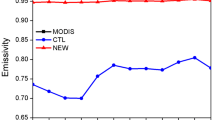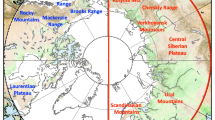Abstract
Snow cover fraction (SCF) has a significant influence on the surface albedo and thus on the radiation balance and surface climate. Long-term three dimensional simulations with general circulation models (GCMs) show that the SCF greatly affects the climate in the Northern Hemisphere. By means of both ground observations and remotely sensed data, several deficiencies in the SCF simulated by the current ECHAM4 GCM were identified: over mountainous areas a substantial overestimation in the SCF was found whereas flat areas showed a distinctly underestimated SCF. This work proposes a new parametrization of the SCF for use in GCMs. Evaluations illustrate that it is beneficial to distinguish between the following three terrains: (1) flat, non-forested areas, (2) mountainous regions and (3) forests. The modified SCF parametrization for flat, non-forested areas was derived by using global datasets of ground-based snow depth and remote sensing observations of snow cover data. A 3-dimensional ECHAM4 simulation showed that this modification raises the SCF by up to approximately 20%, mainly in areas with a relatively thin snow cover. The comparison between remotely sensed and simulated mean monthly surface albedo revealed a significant overestimation of the surface albedo in snow-covered mountainous areas. An extension of the current SCF parametrization in ECHAM4 to take into account mountain effects, based on the French climate model Arpège, yielded a close agreement with satellite-derived surface albedo. The adoption of the submodel for snow albedo, as used in the Canadian Land Surface Scheme (CLASS), combined with a newly developed simple snow interception model, demonstrated the ability to capture the main physical processes of snow-covered canopies, including the albedo. The validation of the new parametrization with Boreal Ecosystem-Atmosphere Study (BOREAS) field data showed that the modification is appropriate to capture the main features of the albedo over snow-covered forests during and after heavy snowfall events. Furthermore, the proposed modification has a beneficial impact on the delayed snow melt in spring, a well-known problem in many current GCMs: The simulated surface albedo over the boreal forests decreases by approximately 0.1 during winter and spring, which is in better agreement with ground-based observations. This induces a significant rise in the surface temperature over extended parts of Eurasia and North America in late spring, which subsequently yields a faster snowmelt and an accelerated retreat of the snow line.
Similar content being viewed by others
Author information
Authors and Affiliations
Additional information
Received: 28 April 2000 / Accepted: 18 December 2000
Rights and permissions
About this article
Cite this article
Roesch, A., Wild, M., Gilgen, H. et al. A new snow cover fraction parametrization for the ECHAM4 GCM. Climate Dynamics 17, 933–946 (2001). https://doi.org/10.1007/s003820100153
Issue Date:
DOI: https://doi.org/10.1007/s003820100153




